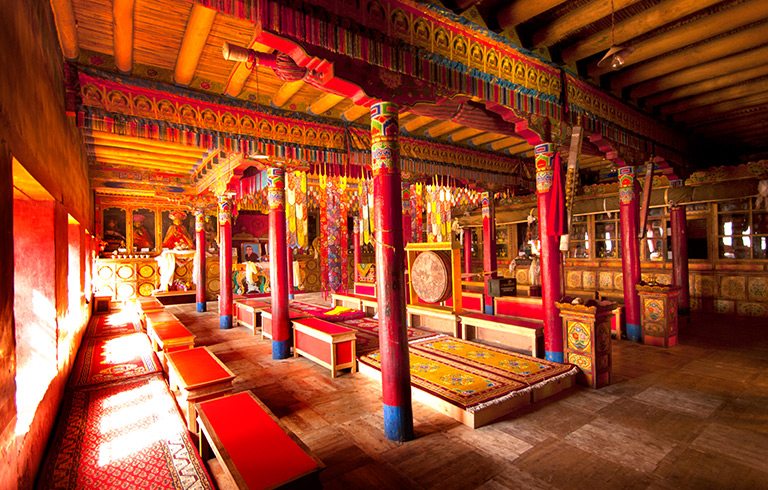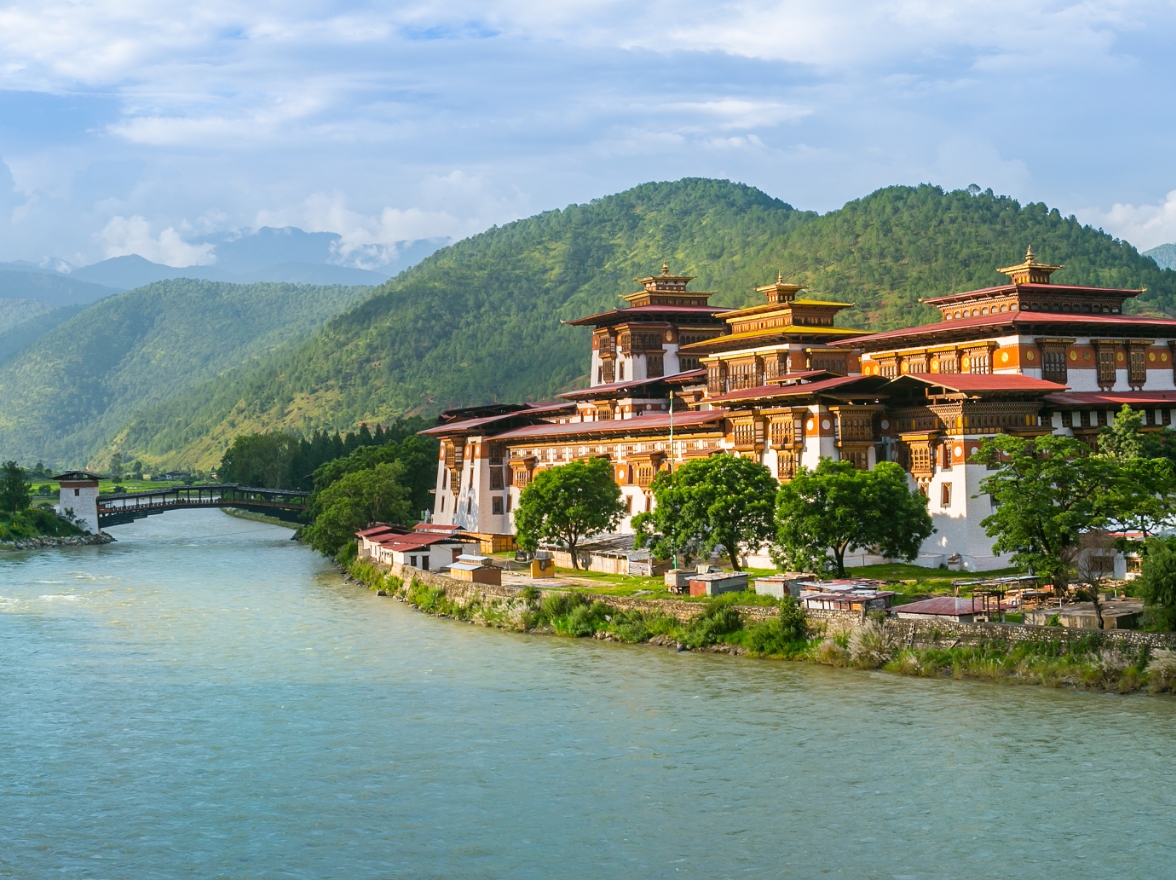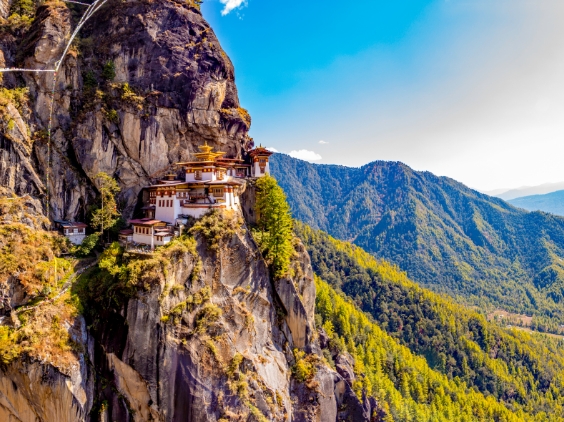

Best of Bhutan
- Paro
- Thimphu
- Phobjikha
- Bumthang
- Lhuentshi
- Trashigang
- Punakha

Get our assistance for easy booking
Want us to call you?Need Assistance? Call us at
+971 4 2055000Inclusions
Detailed Itinerary
Day 1
-
INCLUDED
Flight
Hotel
Transfer
Meals
Sight Seeing
Insurance
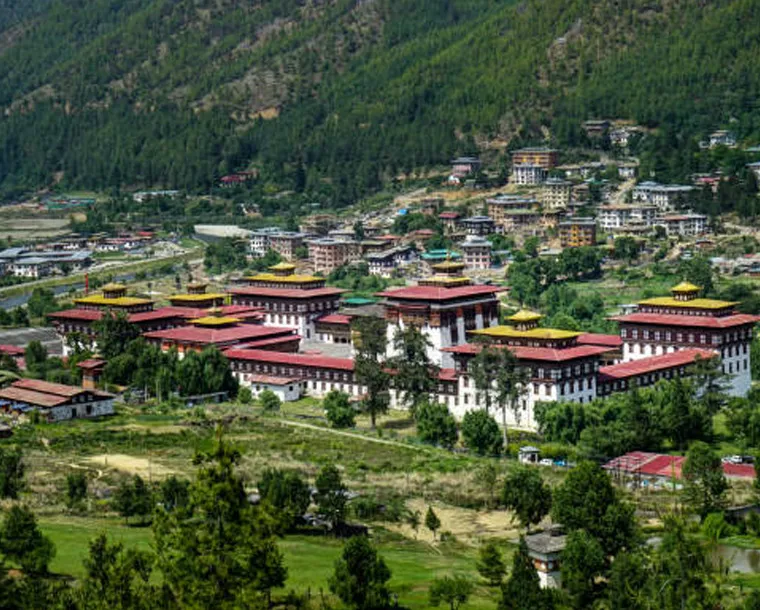
Welcome to Bhutan!
On arrival at Paro International Airport you will be met by our local representative and you will be transferred to the hotel.
Day is free to explore the beautiful valley at your own.
Paro is a valley town in Bhutan, west of the capital, Thimphu. It is the site of the country’s only international airport and is also known for the many sacred sites in the area. North of town, the Taktsang Palphug (Tiger’s Nest) monastery clings to cliffs above the forested Paro Valley. Northwest of here are the remains of a defensive fortress, Drukgyel Dzong, dating from the 17th century.
Bhutan, a Buddhist kingdom on the Himalayas’ eastern edge, is known for its monasteries, fortresses (or dzongs) and dramatic landscapes that range from subtropical plains to steep mountains and valleys. In the High Himalayas, peaks such as 7,326m Jomolhari are popular trekking destinations. Paro Taktsang monastery (also known as Tiger’s Nest) clings to cliffs above the forested Paro Valley.
Overnight in Paro.
Day 2
-
INCLUDED
Flight
Hotel
Transfer
Meals
Sight Seeing
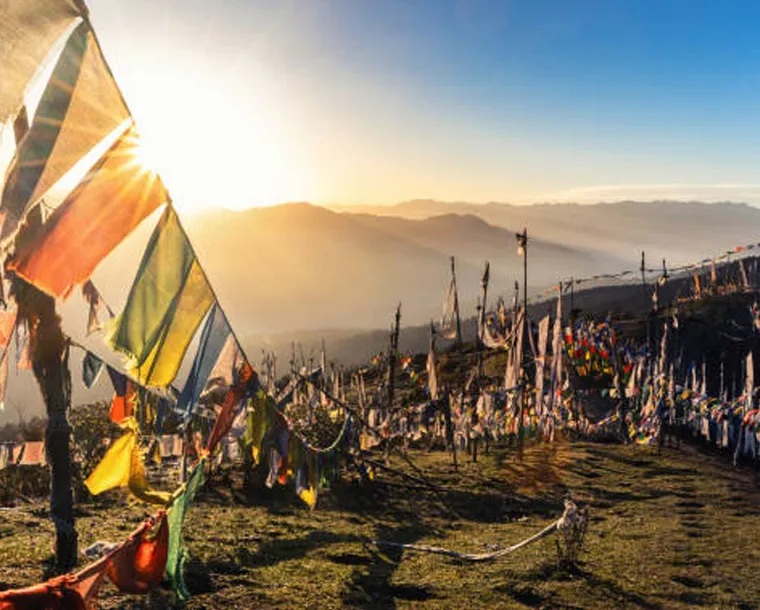
Breakfast at the hotel.
Today you will begin an exciting drive to Chele La Pass, which is at 3990 meters. The pass is dotted with colorful Buddhist prayer flags and offers incredible vistas into the valleys below. From the pass, you will walk along the ridges each higher than the last. On clear weather, you can see stunning views of Mount Jumolhari and Jichu Drake on your right and Mount Kanchenjunga in Sikkim, the world’s third-highest mountain, on your distant left. You will hike till the highest ridge, Kungkarpo which stands at about 4200 meters, the spot for sky burial. You can take well-deserved rest and enjoy spectacular views of the Himalayas. Later you will hike back to your vehicle and drive to Paro
Overnight in Paro.
Day 3
-
INCLUDED
Flight
Hotel
Transfer
Meals
Sight Seeing
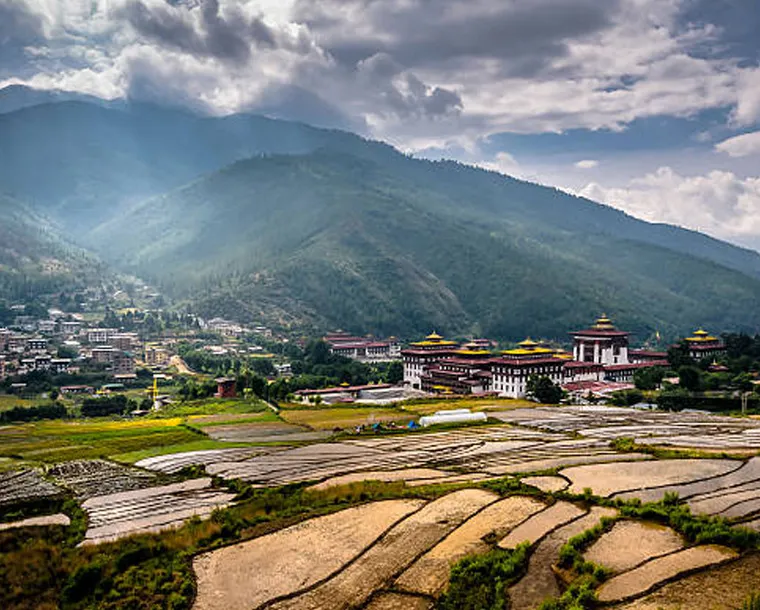
Breakfast at the hotel.
Prepare for check out and the driver will pick you up and drive you Thimphu. On arrival you will proceed for the sightseeing Thimphu. You will be visiting the National Memorial Chorten, Weaving Center, Textile Museums, Bhutanese Paper factory and Handicraft emporium. Lunch will be served in one of the restaurants in Thimphu. Later, in the afternoon, we will do the short hike to Wangditse. The hike starts from BBS tower and ends at Dechenphodrang, through pine forest. The hike will take about 1hour 30 minutes. From this hike, we can see the whole Thimphu town so beautifully. Evening we will visit the Thimphu Tashichhoe Dzong.
Overnight in Thimphu.
Day 4
-
INCLUDED
Hotel
Transfer
Meals
Sight Seeing
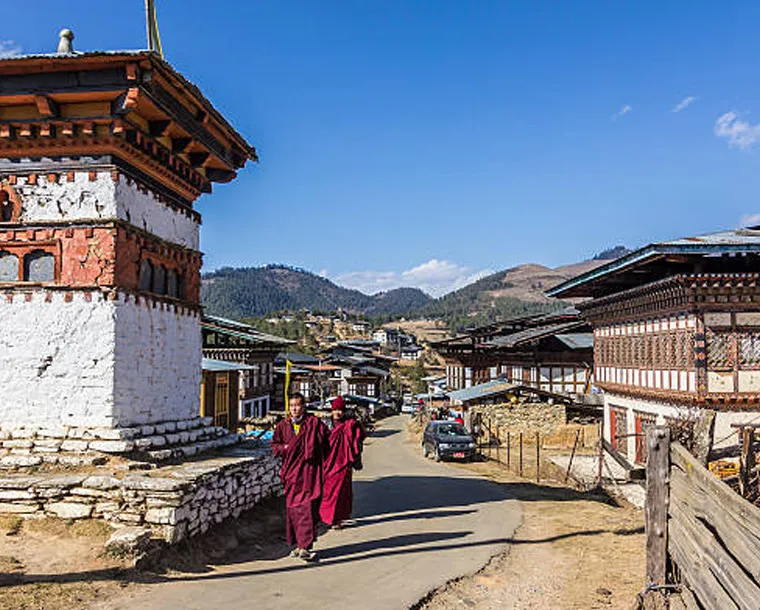
Breakfast at the hotel.
Prepare for check out and the driver will pick you up and drive you to Phobjikha over Dochu-La pass (3150 m). The pass is adorned with different kinds of prayer flags and 108 small stupas. We can witness the eastern Himalayan mountains ranges so magnificently on clear days. We will stop at the Dochula cafeteria to have some time relaxing with tea or coffee. Then we will continue our journey to Phobjikha. Lunch will be served at Wangdi, Dragon Nest Resort. Continue our journey to Phobjikha. The phobia valley is the winter home to the endangered species of birds, Black Neck Crane. On reaching Gangtey, we will visit the Gangtey Goenpa Lhakhang, the temple is the most important temple in Nyingmapa sect.
The Phobjikha Valley spelled as Pho-sbis-kha, is a vast U-shaped valley in central Bhutan. The valley houses one of the impressive ancient Buddhist monasteries in Bhutan known as Gangteng Monastery of the Nyingma sect in central Bhutan.
Overnight in Phobjikha.
Day 5
-
INCLUDED
Hotel
Transfer
Meals
Sight Seeing
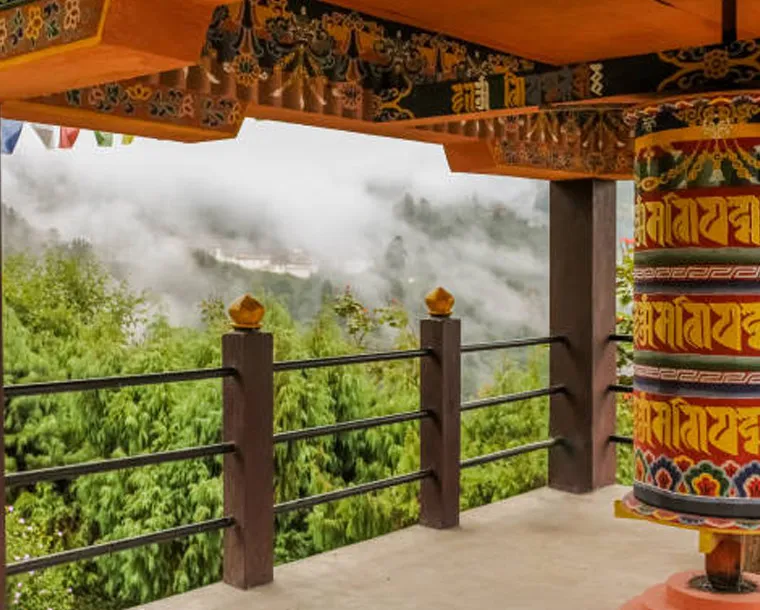
Breakfast at the hotel.
Prepare for check out and the driver will pick you up and drive you to Bumthang. The journey will take about 5hours. On arrival you will visit the ‘Tower of Trongsa’. Trongsa, previously Tongsa, is a Thromde or town, and the capital of Trongsa District in central Bhutan. The name means "new village" in Dzongkha. The first temple was built in 1543 by the Drukpa lama Ngagi Wangchuck, who was the great-grandfather of Ngawang Namgyal, Zhabdrung Rinpoche, the unifier of Bhutan. Lunch at Tower of Trongsa’s Cafeteria. Our journey continues to Bumthang over Yontongla pass. At Chumey, we will stop to see the Yathra textile production. Yathra is a woolen textile. These designs are called yathra (woolen) weaves, and they are a unique speciality that is found only in Bumthang, a legacy that spans back many generations. Bumthang has long, cold winters. Thus, the thick yathra fabric keeps them warm and toasty.
Bumthang District is one of the 20 dzongkhag comprising Bhutan. It is the most historic dzongkhag if the number of ancient temples and sacred sites is counted. Bumthang consists of the four mountain valleys of Ura, Chumey, Tang and Choekhor, although occasionally the entire district is referred to as Bumthang Valley.
Overnight in Bumthang.
Day 6
-
INCLUDED
Hotel
Transfer
Meals
Sight Seeing
Breakfast at the hotel.
Today, we will drive back to Chumey to observe the demonstration of how the woolen textiles are produced, dyed and colored. Lunch at Bumthang Hotel. We will head to Jambay Lhakhang, the oldest monastery in Bhutan. The Jampa Temple or Temple of Maitreya is located in Bumthang in Bhutan, and is said to be one of the 108 temples built by Tibetan King Songtsen Gampo in 659 CE on a single day, to pin down an ogress to earth forever. Kurjey Lhakhang- also known as the Kurjey Monastery, is located in the Bumthang valley in the Bumthang district of Bhutan. This is the final resting place of the remains of the first three Kings of Bhutan. Tamzhing Lhündrup Monastery in Bumthang District in central Bhutan is a Nyingma gompa in Bhutan. Its temple and monastery are remarkable for their direct connection to the Bhutanese tertön and saint, Pema Lingpa and his tulkus. It is now the seat of Sungtrul Rinpoche, the current speech incarnation of Pema Lingpa. Then, we head to the Farm House for dinner, local alcohol, and hot stone bath.
Overnight in Bumthang.
Day 7
-
INCLUDED
Hotel
Meals
Sight Seeing
Tax
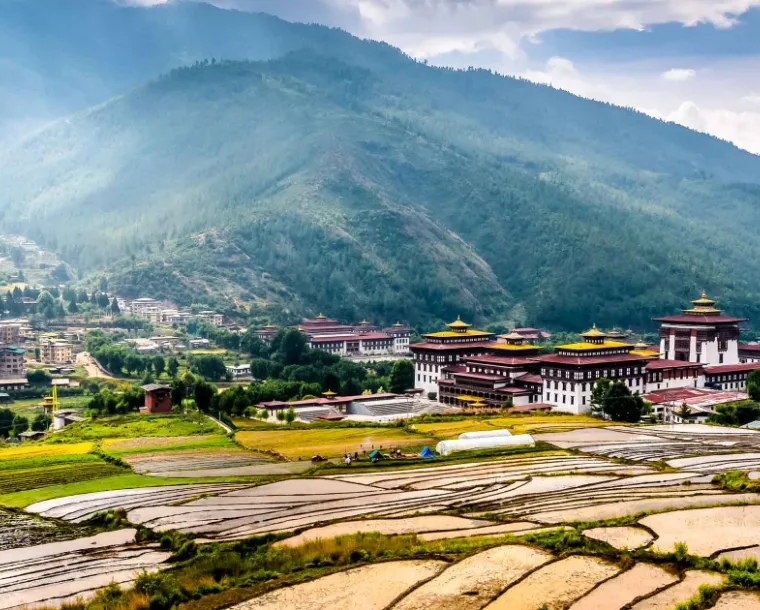
Breakfast at the hotel.
Prepare for check out and the driver will pick you up and drive you to Lhuentshi and the journey will take around 6 hours. Lunch at a picnic pack lunch. En route, stop at certain places for taking some photographs. You will enjoy the scenic beauty of eastern Bhutan. Lhuentshi, especially Khoma Village is renowned for Kushuthara textile production. Kushuthara is the most prestigious Kira for every Bhutanese woman. Kushuthara has a white-filed pattern with dozens of different distinctive motifs, shaped like a diamond or half diamonds at the edges of the field.
Lhuntse District is one of the 20 dzongkhag comprising Bhutan. It consists of 2506 households. Located in the northeast, Lhuntse is one of the least developed dzhongkhags of Bhutan.
Overnight in Lhuentshi.
Day 8
-
INCLUDED
Hotel
Meals
Sight Seeing
Tax
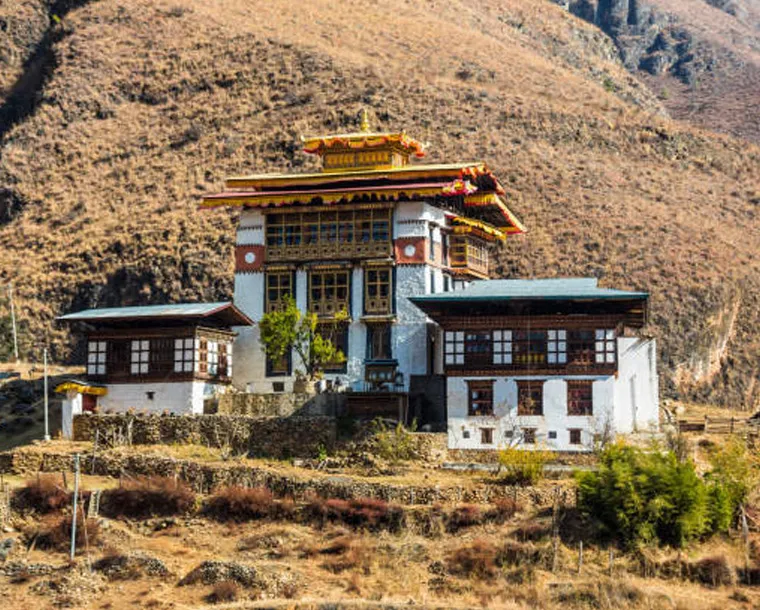
Breakfast at the hotel.
Day is free to explore the mist & untouched country in the world.
Spend the whole day experiencing the dying and the weaving of textiles at your own pace.
Overnight in Lhuentshi.
Day 9
-
INCLUDED
Hotel
Meals
Sight Seeing
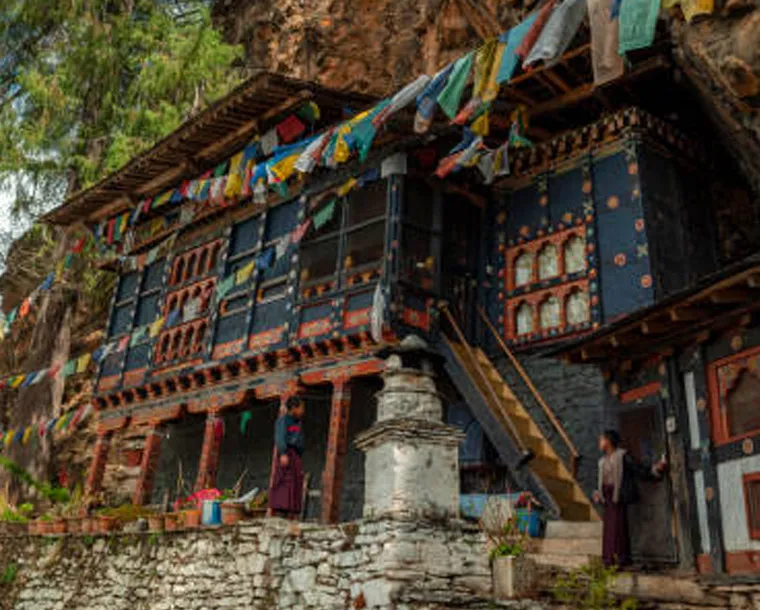
Breakfast at the hotel.
Prepare for check out and the driver will pick you up and drive you and take you to Trashigang, its around 6 hours journey. Lunch at Mongar. Before reaching Trashigang, we will be wandering around the small Trashigang town and then we will drive to Rangjung a town on the Gamri River in the Radhi Gewog of Tashigang District, East Bhutan. The town is the location of Rangjung Oesel Choeling Monastery, established by Dungse Garab Dorje Rinpoche in.
Trashigang, or Tashigang, meaning "fortress of auspicious mount," is a town in eastern Bhutan and the district capital of the Trashigang Dzongkhag. The town lies to the east side of the valley above the Drangme Chhu river just south of where it is joined by the Gamri River.
Overnight in Trashigang.
Day 10
-
INCLUDED
Hotel
Meals
Sight Seeing
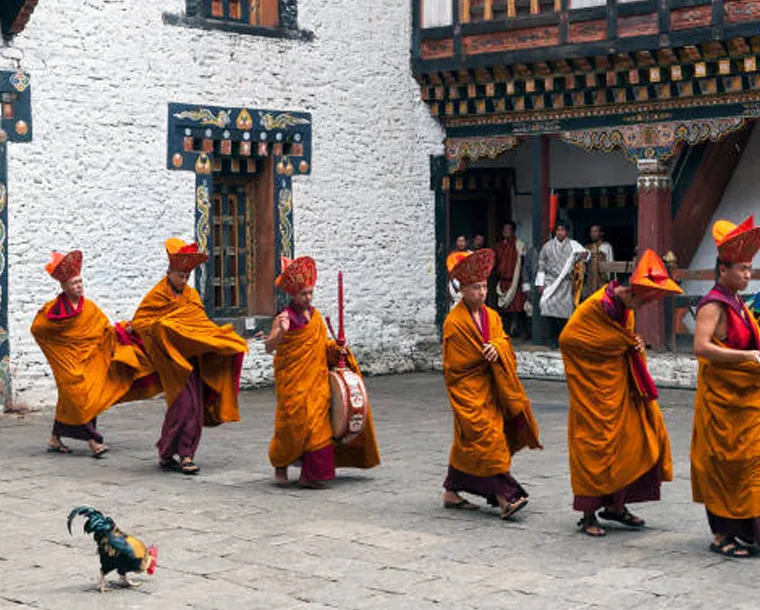
Breakfast at the hotel.
This morning, we head to the Radhi Village and observe the raw silk textile and also the dying and coloring of raw silk. Radhi village is famous for two things, its rice fields and the skill of its weavers. It is often known as the ‘Rice Bowl of the East’ because of its verdant rice fields that supply most of the grain to eastern parts of the country. The village has around 200 households, all of which the people make living from fine raw silk or bura textiles during the off-agricultural seasons. All textiles produced in Radhi are made using the traditional back-strap loom and traditional dyes. As a result, Radhi village produces some of the most authentic high quality raw silk textiles to be found anywhere in Bhutan. Later in the afternoon drive back to the hotel.
Overnight in Trashigang.
Day 11
-
INCLUDED
Hotel
Meals
Sight Seeing
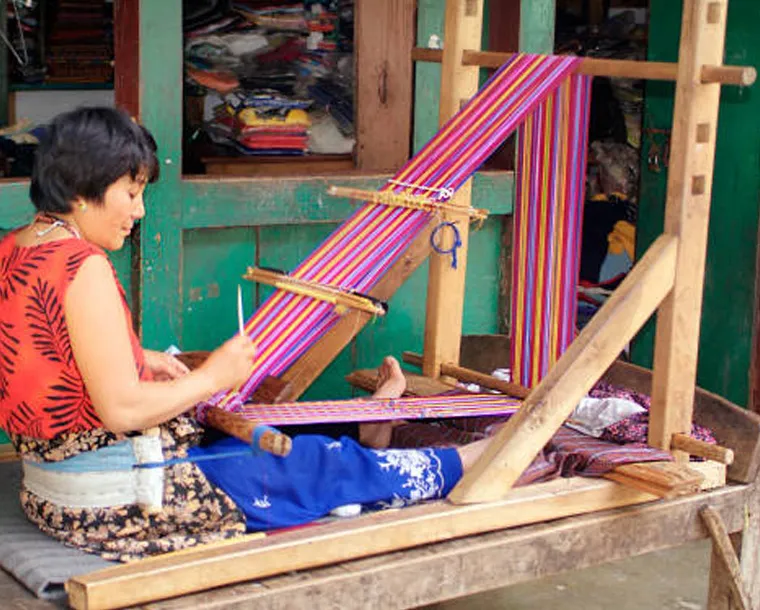
Breakfast at the hotel.
Today will explore to another development center the Khaling Handloom Development center offering us an opportunity to see how the handloom is playing an essential role in promoting the weaving activities in the Kingdom. To promote the age-old tradition of weaving. Develop designs and color combinations; to uphold the old-aged tradition of weaving and vegetable dyeing process.
Overnight in Trashigang.
Day 12
-
INCLUDED
Hotel
Meals
Sight Seeing
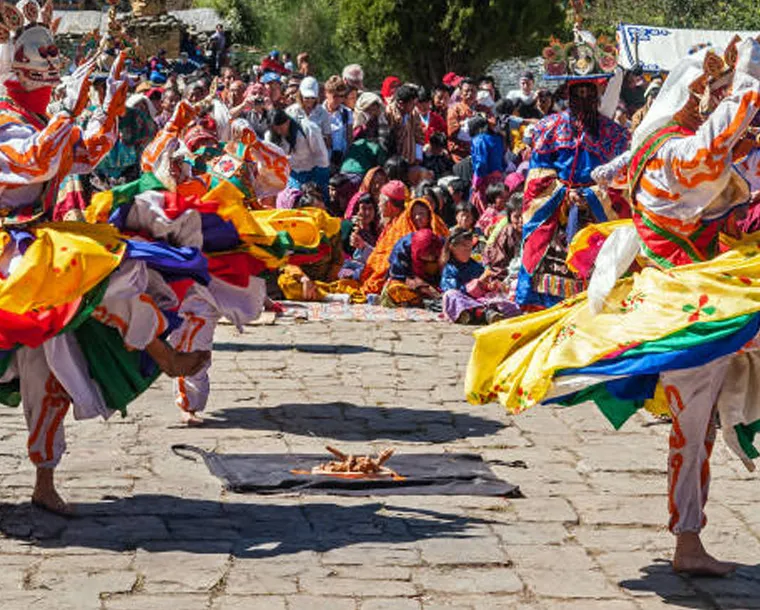
Breakfast at the hotel.
Prepare for check out and the driver will pick you up and drive you to Bumthang.
The journey takes around 7 hours and 30 minutes, but you will enjoy the scenic beauty of the sourroundings. On the way, enjoy a picnic lunch in between the mountain and valleys.
Day is free to explore the magnificent Bumthang at your own pace.
Overnight in Bumthang.
Day 13
-
INCLUDED
Hotel
Meals
Sight Seeing
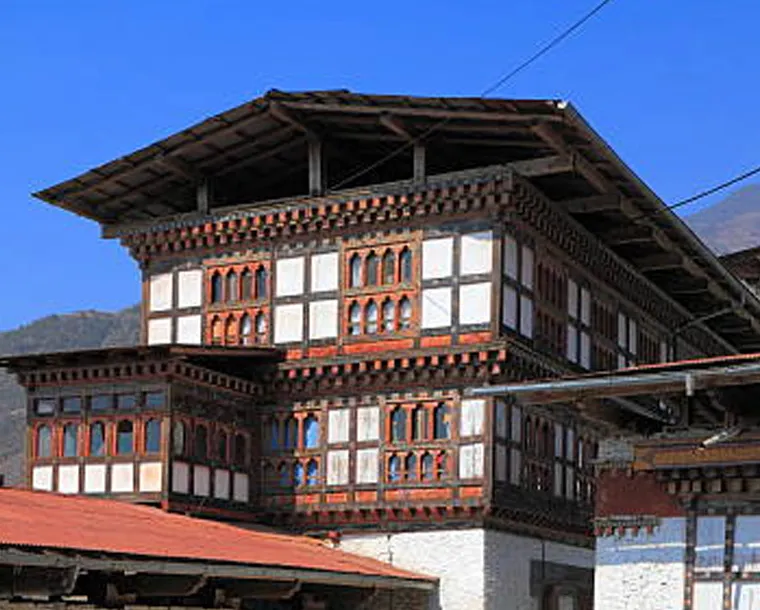
Breakfast at the hotel.
Prepare for check out and the driver will pick you up and take you a pretty nice drive to Punakha. As we reach Trongsa, head to the Trongsa Dzong. The name means "new village" in Dzongkha. The first temple was built in 1543 by the Drukpa lama Ngagi Wangchuck, who was the great-grandfather of Ngawang Namgyal, Zhabdrung Rinpoche, the unifier of Bhutan Then the journey continues to Punakha.
Punakha is a town in the Himalayas of Bhutan. It's known for the Punakha Dzong, a 17th-century fortress at the juncture of the Pho and Mo Chhu rivers. The fortress hosts the Punakha Tshechu, a religious festival featuring masked dances and music. In the surrounding Punakha Valley, temples include the fertility-focused Chimi Lhakhang and the hilltop Khamsum Yulley Namgyal Chorten, which has river and mountain views.
Overnight in Punakha.
Day 14
-
INCLUDED
Hotel
Meals
Sight Seeing
Breakfast at the hotel.
Prepare for check out and the driver will pick you up and take you Punakha. On the way you will visit the most beautiful dzong in Bhutan (Punakha Dzong) at Lobesa, we will hike to Chhimi Lhakhang, the temple of fertility. The temple is located at a hilltop and we have to walk about 30minutes from the road end. Then we will continue our journey to Paro. Evening walk around the Paro town at your own pace.
Paro is a valley town in Bhutan, west of the capital, Thimphu. It is the site of the country’s only international airport and is also known for the many sacred sites in the area. North of town, the Taktsang Palphug (Tiger’s Nest) monastery clings to cliffs above the forested Paro Valley. Northwest of here are the remains of a defensive fortress, Drukgyel Dzong, dating from the 17th century.
Overnight in Paro.
Day 15
-
INCLUDED
Flight
Transfer
Meals

After breakfast.The day is free until checkout time. The driver will pick you up and drop you to the airport for your onward flight.
Tour Cost, Terms & Conditions
Highlights
- AED 11,490/- per person, prices are based on twin sharing.
- Duration: 7 Days / 6 Nights.
- Destinations: Thimphu ,Punakha, Wangdi and Paro.- The rates are subject to availability at the time of booking request. In the event if there are rate changes due to increase in Govt taxes, or hotel charges a surcharge, or BAR rates (Best available rates), we reserve the right to amend the rates without notice. The exchange rate is subject to change. Please ensure that you have secured the relevant visa / entry permits & valid passport. The best source of visa information is the embassy of the country itself.
- If you are interested in going ahead with this booking, we would require deposits or payments as follows either in the form of cash or cheque:
- 30 days to 21 days prior to departure date: 50%.
- 21 days to 01 days prior to departure: 100%.
- Prices in this quotation are subject to availability. Al-Tayer Holidays reserves the right to offer services of similar or higher standard based in the event of non-availability at the time of booking, at amended cost. - Please ensure that the names given to us for reservations match the names in your passport, as hotels, sightseeing tour companies are very particular about name changes. Mismatched names may result in heavy amendment penalties. We strongly recommend travel insurance as part of your package – we have excellent rates with the world’s best companies – please let us know if you wish us to add this to your package.
Inclusions & Exclusions
Inclusions
Flights
- Economy class, Dubai / Delhi / Paro / Delhi / Dubai.
Accommodation
- 1 night in Timphu, Phobjikha & Punakha based on twin sharing basis.
- 2 nights in Lhuentshi based on twin sharing basis.
- 3 nights in Bumthang, Trashigang & Paro based on twin sharing basis.
Transportation
- Return airport transfer in Paro on private car.
Sightseeing
- City Tour in Paro, Thimphu, Phobjikha, Bumthang, Lhuentshi, Trashigang & Punakha on seat in coach.
- Visit the Changangkha Lhakhang, Kuensel Phodrang, Simtokha Dzong, Trongsa Dzong on seat in coach.
- Explore Radhi Village & Khaling Handloom Development center on seat in coach.
Meals
- Daily breakfast.
Insurance
- Complimentary travel insurance.
Taxes
- All airline and hotel taxes.
Exclusions
- Visa fees.
- International airport departure tax.
- Meals not mentioned in the itinerary.
- Items of personal nature viz. telephone calls, drinks, laundry bills, etc.
- Except all above mentioned in inclusion.
Travel Tips
Bhutan - a Buddhist kingdom on the Himalayas’ eastern edge, is known for its monasteries, fortresses (or dzongs) and dramatic landscapes that range from subtropical plains to steep mountains and valleys. In the High Himalayas, peaks such as 7,326m Jomolhari are popular trekking destinations. Paro Taktsang monastery (also known as Tiger’s Nest) clings to cliffs above the forested Paro Valley. The Kingdom of Bhutan is a tranquil country where you can explore the ancient cultures, beautiful landscapes and magnificent architecture. Bhutan, called Druk Yul by its people, is known as the “Land of the Thunder Dragon”. It is one of the world’s most beautiful, yet mysterious places. It is located on the eastern edge of the Himalayan Mountain region. A large part of the area is forested welcoming a diverse ecosystem of flora and fauna. The country stretches from subtropical valleys and plains to snowcapped mountain ranges. This landscape makes it the perfect place to trek through the majestic valleys or steep mountains to visit ancient architecture and Buddhist temples.
Trip Planning: The planning stage of your trip can be instrumental in its success and an enjoyable part of the experience itself. You have a world of options...and plenty to consider.
Entry and Exit formalities: Visitors must hold a passport valid for at least six months & beyond at the time of entering the country. Some nationalities can obtain visa on arrival and for nationalities who requires visa please refer to the Bhutan’s nearest consulate or embassy.
Transportation: Figuring out how to get around is one of your biggest pre-trip decisions. Get our holiday expert best advice on deciding between your options. Based on your trip itinerary, our experts will help you choose wisely. You'll also find a wealth of practical travel tips.
Money: Use your money wisely. Know the best time to use cash or card — and how to avoid unnecessary fees either way — as well as tipping etiquette.
Phones and Technology: Phones and other smart devices can be huge time-savers...or expensive distractions. Get our tips for making the best use of technology during your trip, and for calling home with or without your own phone.
Packing Light: On your trip you'll meet two kinds of travelers: those who pack light and those who wish they had.
Sleeping and Eating: Your hotel and restaurant choices can be a matter-of-face chore…or they can provide rich opportunities to connect with locals and their culture.
Health & Hygiene: Take comfort: Doctors, hospitals, launderettes, and bathrooms aren’t that different. Dealing with them can even be part of the fun of travel.
Sightseeing & Activities: Once you're on the ground, the real fun begins…but it pays to have a thoughtful plan. Our experts will help you get oriented to your surroundings, use your sightseeing hours wisely, and find your way off the beaten path.
Get our assistance for easy booking
Want us to call you?Need Assistance? Call us at
+971 4 2055000Discover & Indulge
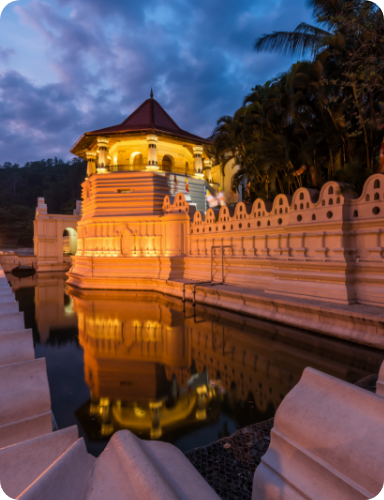
Bhutan’s capital, occupies a valley in the country’s western interior. In addition to being the government seat, the city is known for its Buddhist sites. The massive Tashichho Dzong is a fortified monastery and government palace with gold-leaf roofs. The Memorial Chorten, a whitewashed structure with a gold spire, is a revered Buddhist shrine dedicated to Bhutan’s third king, Jigme Dorji Wangchuck.
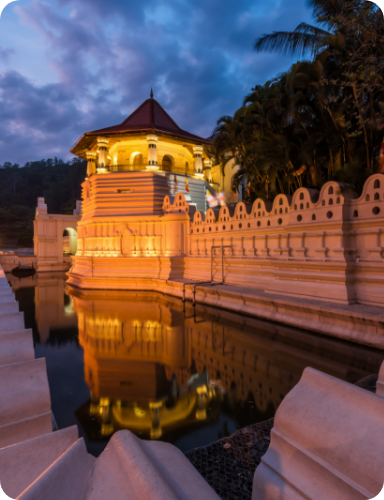
The gateway to Bhutan. Home to Paro Airport, the only international airport. This is where you begin the journey to the land of happiness. Average elevation of 2,300 metres above sea level. Paro is a valley town in Bhutan, west of the capital, Thimphu. It is the site of the country’s only international airport and is also known for the many sacred sites in the area. North of town, the Taktsang Palphug (Tiger’s Nest) monastery clings to cliffs above the forested Paro Valley. Northwest of here are the remains of a defensive fortress, Drukgyel Dzong, dating from the 17th century.
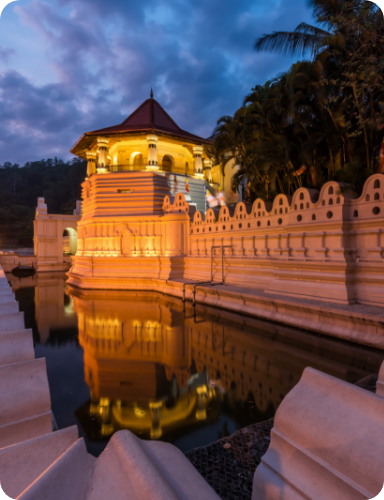
Phuntsholing is a border town in southern Bhutan and is the administrative seat of Chukha District. The town occupies parts of both Phuentsholing Gewog and Sampheling Gewog.
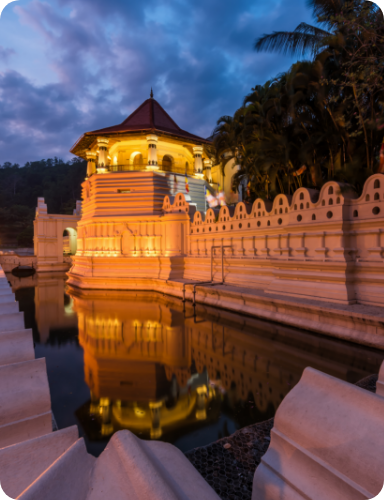
Punakha is a town in the Himalayas of Bhutan. It's known for the Punakha Dzong, a 17th-century fortress at the juncture of the Pho and Mo Chhu rivers. The fortress hosts the Punakha Tshechu, a religious festival featuring masked dances and music. In the surrounding Punakha Valley, temples include the fertility-focused Chimi Lhakhang and the hilltop Khamsum Yulley Namgyal Chorten, which has river and mountain views.
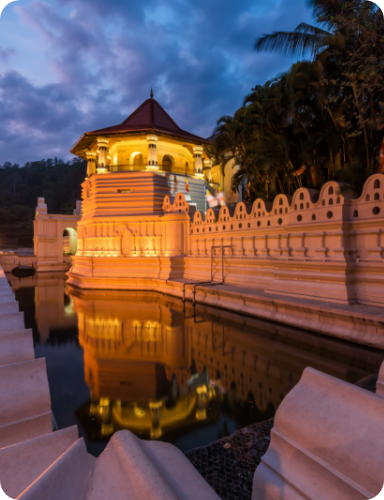
Wangdue Phodrang is a town and capital of Wangdue Phodrang District in central Bhutan. It is located in Thedtsho Gewog.
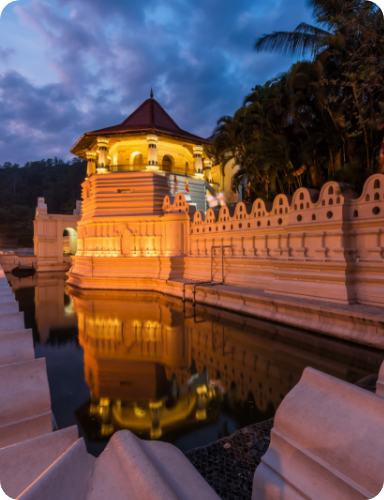
Jakar also officially referred to as Bumthang, is a town in the central-eastern region of Bhutan. It is the district capital of Bumthang District and the location of Jakar Dzong, the regional dzong fortress.
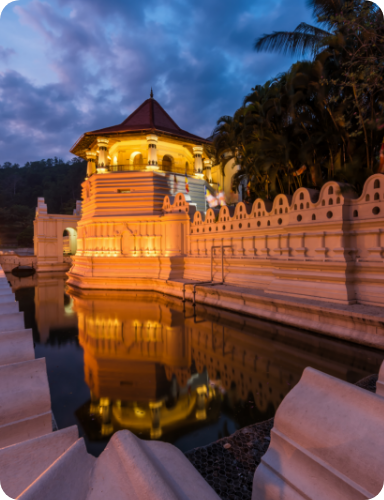
Trongsa, previously Tongsa is a Thromde or town, and the capital of Trongsa District in central Bhutan. The name means "new village" in Dzongkha. The first temple was built in 1543 by the Drukpa lama Ngagi Wangchuck, who was the great-grandfather of Ngawang Namgyal, Zhabdrung Rinpoche, the unifier of Bhutan.
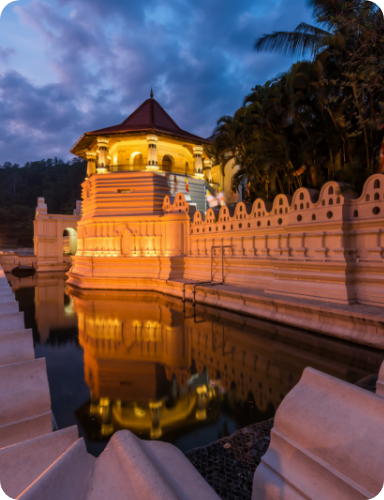
Trashigang, or Tashigang - is a town in eastern Bhutan and the district capital of the Trashigang Dzongkhag. The town lies to the east side of the valley above the Drangme Chhu river just south of where it is joined by the Gamri River.
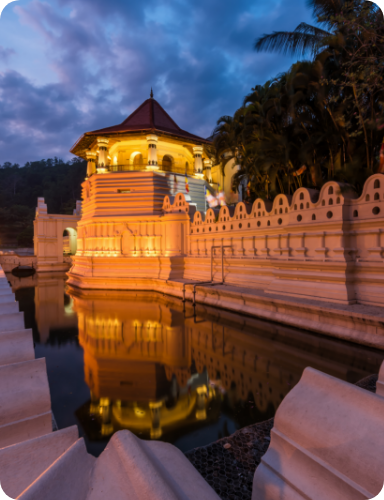
Gelephu also spelled as Gelyephug, Gelegphu, Gaylegphug or Gaylephug, is a town or Thromde in Sarpang District in Bhutan. It is located on the Indian border, about 30 km to the east of Sarpang, the Dzongkhag headquarters.
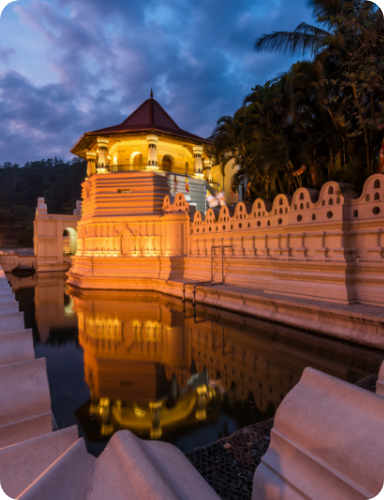
Samtse near the Indian border town of Chamurchi, is a town in Samtse District, Bhutan. This is not to be confused with the district of Samtse, which the village of Samtse lies within.
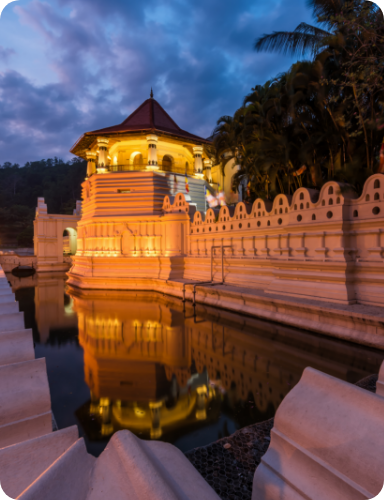
Samdrup Jongkhar is a town and seat of Samdrup Jongkhar District in Bhutan. The town is located at the south-eastern part of Bhutan and borders the Indian state of Assam.
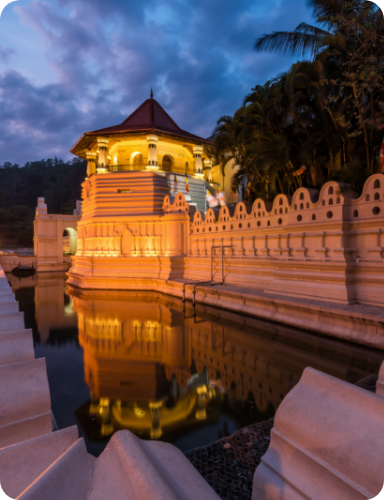
Mongar is a town and the seat of Mongar District in eastern Bhutan. As of 2005 it had a population of 3502. Mongar is on the road from Thimphu to Trashigang. It is one of the oldest educational hubs of the country. It has a regional hospital and a good standard hotel, among other facilities.

